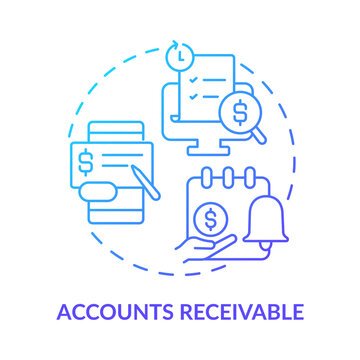Accounts Receivable in Cash Flow Forecasting: The Critical Role for U.S. Companies
The Critical Role of Accounts Receivable in Cash Flow Forecasting for U.S. Companies In today’s volatile business environment, maintaining a healthy cash flow is more than a financial goal — it’s a necessity. One often underestimated factor that plays a key role in cash flow forecasting is accounts receivable (AR). For U.S. companies, especially small to mid-sized enterprises, understanding the role of accounts receivable in cash flow forecasting can be the difference between thriving and struggling. Understanding Accounts Receivable (AR) Accounts receivable refers to the money your customers owe for goods or services delivered on credit. For U.S. companies, AR reflects expected future cash inflows and sits as a current asset on the balance sheet. Every unpaid invoice represents future cash — but when that cash will actually arrive is often uncertain. What Is Cash Flow Forecasting? Cash flow forecasting involves estimating how much money will flow in and out of your business over a period. It helps U.S. businesses: Predict potential cash shortfalls Plan for expansion or cost-cutting Make confident financial decisions The two components are: Cash inflows (revenue, loans, AR collections) Cash outflows (expenses, debt repayments, payroll) How Accounts Receivable Affects Cash Flow Accounts receivable directly impacts cash inflows. If your business has a large amount of outstanding receivables but collections are delayed, your forecast might appear strong on paper but result in actual cash shortages. The timing of AR collections plays a critical role. A 30-day payment term might sound fine, but if customers pay in 60 days, you’re misaligned with your forecast — which can lead to overdrafts, missed payments, or even lost opportunities. Common AR Issues That Hurt Cash Flow U.S. companies often face these AR-related challenges: Late payments from clients Disorganized invoicing systems Lack of follow-up or automated reminders Failure to assess creditworthiness Each of these can distort your forecast and lead to poor financial decisions. Using AR Data for Accurate Forecasting To leverage accounts receivable in cash flow forecasting, businesses should analyze: AR aging reports: Know which invoices are overdue Customer payment history: Spot patterns and delays Expected vs. actual collections Modern accounting tools allow syncing AR data directly into forecasting dashboards, providing real-time insights. Best Practices for Managing AR in Forecasting Set and enforce clear payment terms Automate your AR processes using invoicing software Regularly update AR reports Train your team on the importance of AR in planning AR Metrics That Matter Tracking these metrics helps U.S. companies forecast better: Days Sales Outstanding (DSO): Average number of days to collect payment AR Turnover Ratio: How efficiently you’re collecting Average Collection Period: Time taken to turn AR into cash The lower these numbers, the healthier your cash flow will likely be. Case Study: From Chaos to Clarity A mid-sized manufacturing firm in Ohio was struggling with inaccurate forecasts. Their AR team wasn’t aligned with finance, and they often had unexpected cash shortfalls. By integrating their AR software with a forecasting platform and introducing strict follow-up systems, they reduced their DSO from 53 days to 34 days. The result? A 22% increase in cash-on-hand and improved budget planning. Helpful Tools for U.S. Companies To integrate accounts receivable in cash flow forecasting, try: QuickBooks Online: AR + cash flow tools Zoho Books: Invoicing + AR analytics Float or Planful: Dedicated forecasting platforms NetSuite ERP: Advanced, all-in-one solution Benefits of Aligning AR with Forecasting More accurate cash planning Better risk mitigation Faster decision-making Improved credit control When AR is correctly forecasted, your business can operate confidently without surprises. Challenges to Watch Out For Despite its importance, aligning AR and forecasting isn’t always easy. Watch out for: Inconsistent customer behavior Fluctuating market conditions Data silos between AR and finance departments Expert Tips for U.S. Finance Teams Conduct monthly AR reviews Hold cash flow planning meetings cross-functionally Use visual dashboards for instant clarity Invest in training on AR’s financial impact Conclusion Accounts receivable in cash flow forecasting is not just a line item — it’s a financial lifeline. For U.S. companies looking to improve liquidity, plan ahead, and grow confidently, integrating AR into your forecasting process is a strategic must.
Read MoreMastering Accounts Receivable: Boost Cash Flow for Your U.S. Business
Managing a business in the USA involves many moving parts, but one crucial component often overlooked is Accounts Receivable (AR). While sales might drive revenue, it’s your receivables that determine whether you actually see that money in your account. Efficient accounts receivable management ensures you get paid on time, reduces cash flow problems, and strengthens your business’s financial health. In this blog, we’ll explain what AR is, why it matters, and how U.S. businesses can master it to scale successfully. What Are Accounts Receivable? Accounts Receivable refers to the outstanding invoices a business has issued to its clients for goods or services already delivered but not yet paid for. In short, AR is money your customers owe you. These receivables are recorded as current assets on your balance sheet because they are expected to be converted into cash within a short period, usually 30–90 days. Why Accounts Receivable Management Matters 1. Improves Cash Flow Late payments tie up your money, making it hard to meet operational costs like payroll, rent, or inventory. Proper AR processes keep your cash flowing consistently and predictably. 2. Reduces Bad Debt Not all customers will pay on time—or at all. Having a system for following up and tracking payment history can help you identify risky clients early and avoid financial losses. 3. Boosts Customer Relationships Clear invoicing and timely reminders demonstrate professionalism and build trust. Clients are more likely to pay on time when the process is easy and well-managed. 4. Supports Business Growth When receivables are collected efficiently, you have more capital to reinvest in your business—whether it’s hiring, marketing, or expanding your services. The Accounts Receivable Workflow: Key Steps Managing AR isn’t just about sending an invoice and waiting for a check. A proper workflow can make all the difference: • Credit Assessment Before providing services on credit, assess the customer’s payment history or credit score. • Clear Terms Clearly state your payment terms on every invoice. For example: “Payment due within 30 days.” • Prompt Invoicing Send invoices immediately after delivering your product or service. Delays can lead to confusion and late payments. • Tracking and Reminders Use accounting software to track which invoices are paid, overdue, or upcoming. Set automatic reminders to avoid chasing manually. • Collections Policy Establish a process for handling late payments. This may include follow-up emails, phone calls, or using collection agencies as a last resort. Common AR Challenges Faced by U.S. Businesses Even successful companies can run into issues if AR isn’t managed well. Some common challenges include: Clients who delay payments beyond the due date Invoices getting lost or forgotten Manual tracking leading to errors or missed follow-ups Lack of staff dedicated to receivables Poor communication with clients over payment terms Best Practices for Accounts Receivable Management To overcome those challenges, consider implementing the following best practices: 1. Automate Invoicing Use platforms like QuickBooks, FreshBooks, or Xero to send invoices, set payment reminders, and track receivables all in one place. 2. Offer Multiple Payment Options Make it easy for customers to pay. Accept credit cards, ACH transfers, online payment links, and mobile payments to improve collection rates. 3. Monitor Key Metrics Track Days Sales Outstanding (DSO), Average Collection Period, and Aging Reports to stay ahead of potential cash flow issues. 4. Create an AR Aging Report Segment your receivables by how long they’ve been outstanding (e.g., 0–30 days, 31–60 days, etc.). This helps prioritize follow-up efforts. 5. Outsource AR Services If you’re short-staffed or growing fast, consider outsourcing accounts receivable management to professionals who specialize in collections and customer communication. Benefits of Outsourcing Accounts Receivable Services in the USA More U.S. companies are turning to outsourced accounting services to manage AR efficiently. Here’s why: Cost Savings: Avoid hiring full-time staff Faster Collections: Dedicated follow-up increases payment speed Expertise: Get help from professionals who understand AR regulations and client handling Advanced Tools: Gain access to the latest AR software without investing in expensive licenses Accounts Receivable and Tax Compliance In the USA, AR is closely tied to tax planning and compliance. Revenue recognition can impact when and how you report income to the IRS. Having detailed records of your receivables ensures: Accurate tax filings Easier audits Proper matching of income with expenses Work with an accountant who understands U.S. GAAP (Generally Accepted Accounting Principles) or cash vs accrual accounting methods to remain compliant. Final Thoughts Efficient accounts receivable management is essential for the survival and growth of any business. For U.S. entrepreneurs, where competition is fierce and cash flow is critical, mastering AR can give you the edge you need. Whether you’re a startup or a growing enterprise, implementing a strong AR process—or partnering with a reliable accounting service—will ensure your revenue turns into real cash, keeping your operations smooth and sustainable.
Read MoreThe Importance of Effective Accounts Receivable Management in 2025
In today’s fast-moving business environment, cash flow is king. Even profitable companies can run into serious trouble if their cash isn’t flowing in on time. That’s why managing your Accounts Receivable (AR) is critical to your business’s long-term health and sustainability. For growing businesses across the USA, improving how you track and collect customer payments can make the difference between thriving or barely surviving. Whether you’re a logistics provider, retail brand, service firm, or Amazon DSP, effective accounts receivable management boosts your revenue, protects your cash flow, and minimizes bad debt. What Is Accounts Receivable? Accounts Receivable refers to the outstanding invoices a business has—the money owed to you by your customers for products or services already delivered. These are legally enforceable claims for payment. When you send an invoice and wait for payment, that amount sits as an asset on your balance sheet. But if too much cash is locked up in unpaid invoices, it can hurt your ability to pay vendors, invest in growth, or meet payroll. Why Accounts Receivable Management Matters 1. Improved Cash Flow Late payments tie up your working capital. Efficient AR processes ensure faster payments, giving your business the liquidity needed to operate smoothly. 2. Stronger Customer Relationships A professional invoicing and follow-up process makes your business look more credible. You can maintain a positive relationship while encouraging timely payments. 3. Reduced Bad Debt Without a solid AR system, overdue invoices can slip through the cracks. Tracking and following up consistently helps minimize write-offs and improves recovery rates. 4. Better Decision-Making Accurate accounts receivable data gives you a clearer picture of your revenue pipeline and helps with budgeting, forecasting, and financial planning. 5. Credit Risk Management Managing AR also includes setting credit limits for customers, helping you avoid overextending payment terms to high-risk clients. Key Components of an Effective Accounts Receivable System To manage AR successfully, your business should include these critical processes: ✅ Invoicing and Billing Generate clear, timely, and accurate invoices with detailed payment terms and due dates. ✅ Automated Reminders Send regular payment reminders via email, SMS, or your client portal to reduce late payments. ✅ Payment Processing Offer multiple payment options (ACH, credit cards, checks, digital wallets) to make paying easier for customers. ✅ Aging Reports Monitor unpaid invoices by age to track which customers are late and by how long—30, 60, 90 days, etc. ✅ Dispute Management Resolve billing disputes quickly and maintain clear communication with clients to prevent delays. ✅ Collections Strategy Have a defined process for escalating overdue invoices—starting with polite reminders and ending with formal collection efforts, if necessary. Common AR Challenges Faced by Small Businesses Even businesses with steady sales can fall into AR traps. Common issues include: Sending invoices late or with errors Lack of follow-up or inconsistent reminders Poor credit assessment of new clients No system to track overdue payments Not offering flexible payment options These challenges can be solved by implementing professional AR services or outsourcing to a specialist provider. Benefits of Outsourcing Accounts Receivable Services Many small businesses in the USA are turning to outsourced AR providers to manage this complex task. Here’s why: 1. Faster Collection Times Specialized AR teams have proven strategies to collect payments quickly and professionally. 2. Improved Efficiency Outsourcing frees up your internal staff to focus on core operations rather than chasing invoices. 3. Advanced Technology AR firms use automation tools, dashboards, and analytics that give you full visibility into your receivables. 4. Reduced Delinquencies Systematic follow-ups and credit management result in fewer overdue accounts and bad debts. 5. Cash Flow Forecasting Professionals help you predict inflows, which is essential for planning expansion, hiring, and investments. Industries That Rely Heavily on AR Services Logistics and TransportationDelayed payments from shipping partners can disrupt operations. AR services keep the money moving. E-commerce and RetailManaging bulk orders, refunds, and client terms requires strong invoice tracking. Healthcare and ClinicsInsurance reimbursements and patient billing need constant follow-up. Service-Based BusinessesConsulting, IT, and marketing firms rely on timely payments to fund operations. Tools That Improve AR Management Look for AR solutions that offer: Invoice AutomationAuto-generate invoices based on service completion or delivery confirmation. Customer PortalsLet clients track invoices and make payments in one place. Integration with Accounting SoftwareConnect AR systems with QuickBooks, Xero, or FreshBooks for end-to-end tracking. Customizable ReportsView who owes you, how much, and for how long with real-time dashboards. Final Thoughts Accounts receivable is more than a back-office function—it’s the heartbeat of your business’s cash flow. When managed properly, it improves financial stability, supports growth, and reduces stress. But when overlooked, even a profitable company can struggle to stay afloat. By investing in professional accounts receivable services or modern AR automation tools, you ensure your business stays financially healthy, customers pay on time, and growth opportunities aren’t stalled by unpaid invoices.
Read More


